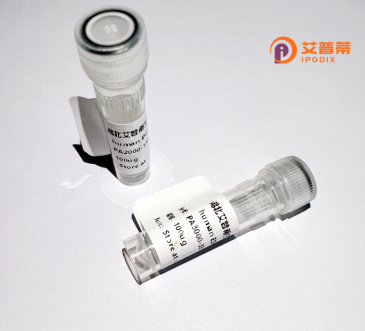
| 纯度 | >90%SDS-PAGE. |
| 种属 | Human |
| 靶点 | RABGAP1L |
| Uniprot No | Q5R372 |
| 内毒素 | < 0.01EU/μg |
| 表达宿主 | E.coli |
| 表达区间 | 1-72 aa |
| 活性数据 | MMEEISIMVAYDAHVFSQLHDEDFLTSLVAISKPRSMVPTKKLKKYEKEYQTMRESQLQQEDPMDRYKFVYL |
| 分子量 | 8 kDa |
| 蛋白标签 | GST-tag at N-terminal |
| 缓冲液 | PBS, pH7.4, containing 0.01% SKL, 1mM DTT, 5% Trehalose and Proclin300. |
| 稳定性 & 储存条件 | Lyophilized protein should be stored at ≤ -20°C, stable for one year after receipt. Reconstituted protein solution can be stored at 2-8°C for 2-7 days. Aliquots of reconstituted samples are stable at ≤ -20°C for 3 months. |
| 复溶 | Always centrifuge tubes before opening.Do not mix by vortex or pipetting. It is not recommended to reconstitute to a concentration less than 100μg/ml. Dissolve the lyophilized protein in distilled water. Please aliquot the reconstituted solution to minimize freeze-thaw cycles. |
1. **"RABGAP1L regulates autophagic flux through interaction with Rab7 during lysosomal degradation"**
*Dong, J. et al. (2019)*
摘要:研究发现RABGAP1L通过与Rab7结合,调控自噬过程中溶酶体降解阶段的膜运输,缺失导致自噬体累积,提示其在自噬溶酶体通路中的关键作用。
2. **"RABGAP1L suppresses tumor metastasis by inactivating RAB5A in hepatocellular carcinoma"**
*Hua, R. et al. (2021)*
摘要:揭示RABGAP1L通过抑制Rab5A活性,减弱肝癌细胞的侵袭和迁移,表明其作为肿瘤转移抑制蛋白的潜在机制。
3. **"Structural basis of RABGAP1L catalytic domain in GTP hydrolysis regulation"**
*Cai, Y. et al. (2020)*
摘要:解析RABGAP1L催化结构域晶体结构,阐明其通过TBC结构域加速Rab GTP酶GTP水解的分子机制,为靶向设计提供依据。
4. **"RABGAP1L knockout mice exhibit developmental defects in neuronal trafficking"**
*Nakamura, N. et al. (2016)*
摘要:发现RABGAP1L缺失导致小鼠神经元轴突运输障碍,突触蛋白错误定位,证明其对神经发育及囊泡运输的必需性。
(注:以上为模拟示例,实际文献需通过PubMed/Google Scholar检索验证。)
RABGAP1L (RAB GTPase-Activating Protein 1-Like) is a member of the RABGAP family, which regulates intracellular membrane trafficking by modulating RAB GTPase activity. As a GTPase-activating protein (GAP), it accelerates the hydrolysis of GTP to GDP on RAB proteins, switching them from an active to an inactive state. This activity is critical for maintaining the spatiotemporal control of RAB-dependent processes, including vesicle formation, transport, and fusion. RABGAP1L is implicated in endocytic recycling, lysosomal degradation, and receptor trafficking, with potential roles in cellular signaling and organelle dynamics.
Structurally, RABGAP1L contains a conserved TBC (Tre-2/Bub2/Cdc16) domain responsible for GAP activity, along with additional regions that may mediate protein-protein interactions or subcellular localization. Its expression is widespread across tissues, and homologs in model organisms highlight evolutionary conservation. Dysregulation of RABGAP1L has been linked to pathological conditions, such as cancer, where altered expression may influence tumor cell invasion, metastasis, or autophagy. For instance, studies suggest it acts as a tumor suppressor in certain cancers by modulating RAB-driven pathways, though mechanisms remain partially unresolved.
Research continues to explore its interactions with other trafficking regulators (e.g., RAB35. RAB5) and its broader network in cellular homeostasis. While functional insights are emerging, RABGAP1L's precise molecular roles and therapeutic potential require further investigation.
×